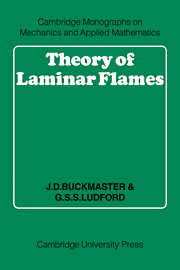Book contents
- Frontmatter
- Contents
- Preface
- 1 Governing equations of combustion
- 2 The premixed plane flame
- 3 Perturbations: SVFs and NEFs
- 4 Steady burning of a linear condensate
- 5 Unsteady burning of a linear condensate
- 6 Spherical diffusion flames
- 7 Cylindrical and spherical premixed flames
- 8 Multidimensional theory of premixed flames
- 9 Burners
- 10 Effects of shear and strain
- 11 Stability
- 12 Ignition and explosion
- Text references
- Further references
- Citation Index
- Subject Index
6 - Spherical diffusion flames
Published online by Cambridge University Press: 05 May 2010
- Frontmatter
- Contents
- Preface
- 1 Governing equations of combustion
- 2 The premixed plane flame
- 3 Perturbations: SVFs and NEFs
- 4 Steady burning of a linear condensate
- 5 Unsteady burning of a linear condensate
- 6 Spherical diffusion flames
- 7 Cylindrical and spherical premixed flames
- 8 Multidimensional theory of premixed flames
- 9 Burners
- 10 Effects of shear and strain
- 11 Stability
- 12 Ignition and explosion
- Text references
- Further references
- Citation Index
- Subject Index
Summary
Diffusion flames
Earlier chapters have been concerned with flames for which the reactants are supplied already mixed. When two reactants are initially separate and diffuse into each other to form a combustible mixture, the term diffusion flame applies. A Bunsen burner with its air hole closed supports a diffusion flame between the gas supplied through the tube and the surrounding oxygen-rich atmosphere. A candle supports a vapor diffusion flame, so called because the fuel is produced by liquefaction and subsequent evaporation of the wax caused by the heat of the flame.
Premixed and diffusion flames share certain features, but there are important differences. For example, there is no unlimited plane flame with fuel supplied far upstream, oxidant far downstream. The only bounded solutions of the chemistry-free equations behind the flame sheet are constants, so that the oxidant fraction would be constant there, with no mechanism to generate the necessary flux towards the reaction zone. Supplying the fuel at a finite point upstream does not change this picture. Moreover, since cylindrical flames are geometrically attenuated versions of plane flames (cf. section 7.2), there is no cylindrical diffusion flame either.
To gain insight into the nature of diffusion flames we seek a simple onedimensional configuration that has some physical reality. One possibility is to introduce the oxidant at a finite point in the plane flame; details of that choice have been worked out by Lu (1981).
- Type
- Chapter
- Information
- Theory of Laminar Flames , pp. 95 - 119Publisher: Cambridge University PressPrint publication year: 1982



